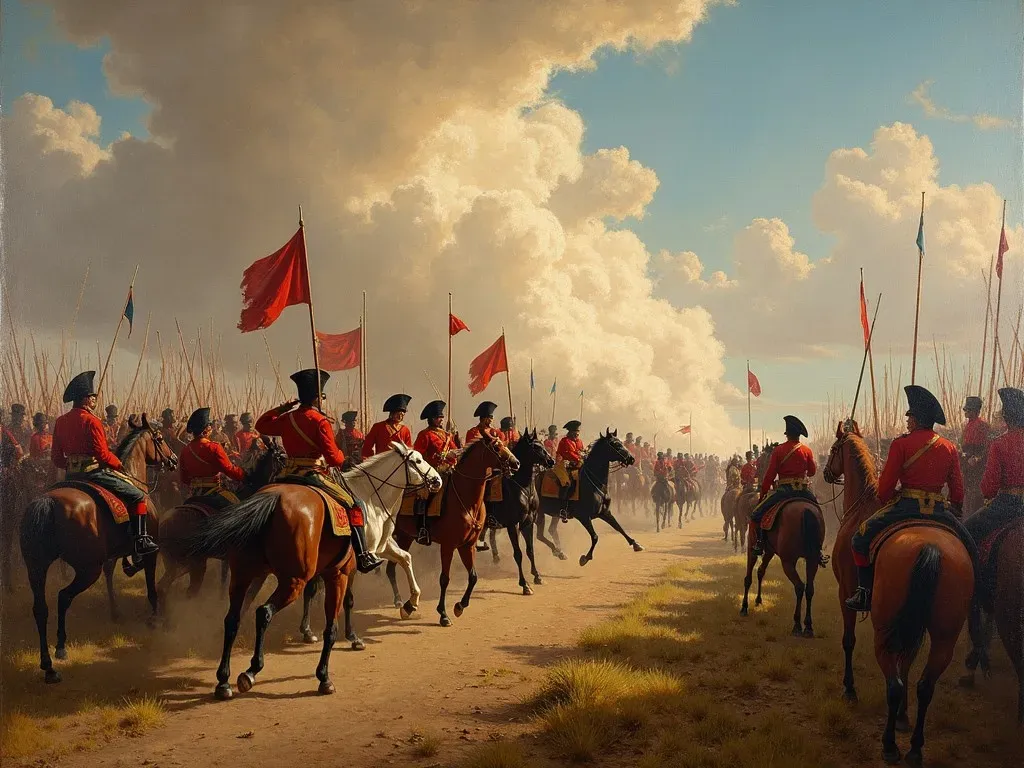Battle paintings, also known as war paintings or old war paintings, are artworks that masterfully depict military conflicts, capturing not just the chaos of battle but also the deeper narratives of heroism and suffering that surround them. These historical oil paintings serve as visual documentation of significant events in human history, offering insights into the emotions, tactics, and outcomes of warfare throughout the ages.
The Artistic Legacy of Battle Paintings
Battle paintings have a long-standing tradition in the art world, representing historical events that have shaped nations and cultures. Artists throughout history have been drawn to these themes, using their skills to immortalize the bravery and tragedy of warfare.
Famous Battle Paintings and Their Significance
Some of the most renowned battle paintings include:
| Painting Title | Artist | Year | Historical Event |
|---|---|---|---|
| The Battle of San Romano | Paolo Uccello | 1432 | Battle of San Romano |
| The Surrender of Breda | Diego Velázquez | 1635 | The Siege of Breda |
| Liberty Leading the People | Eugène Delacroix | 1830 | July Revolution in France |
| The Battle of Grunwald | Jan Matejko | 1878 | The Battle of Grunwald |
| The Menin Road | Paul Nash | 1919 | World War I – Battle of the Somme |
These paintings are not merely artistic representations; they are also rich in symbolism, often conveying ideals of honor, sacrifice, and the stark realities of conflict. Each piece encapsulates the political and social dynamics of its time, teaching viewers about the past through visual storytelling.
Styles and Techniques of Battle Paintings
Artists employ various styles and Techniques to bring battle scenes to life. The use of dramatic lighting, dynamic compositions, and vivid color palettes often characterize these paintings. Let’s explore some of the prominent styles used in battle paintings:
- Realism: Many battle painters focus on realistic depictions of events, capturing the raw emotions and true-to-life details of warfare.
- Romanticism: This style emphasizes the emotional responses to battle, highlighting themes of heroism and national pride.
- Impressionism: Some artists have taken a more abstract approach, using light and color to convey the mood and atmosphere of a battle rather than the exact details.
Influential Artists in Battle Painting History
Several artists have left an indelible mark on the genre of battle paintings. Their contributions have helped shape the narrative of war in art.
- Paolo Uccello – Known for his depiction of perspective and movement in battle scenes, such as “The Battle of San Romano”.
- Eugène Delacroix – Renowned for his expressive brushwork and ability to capture drama, evident in “Liberty Leading the People”.
- Francisco Goya – His works like “The Third of May 1808” focus on the human cost of war, showcasing fear and suffering.
- John Singer Sargent – His painting “Gassed” portrays the grim reality of World War I, emphasizing the plight of soldiers.
Reference Video
The Impact of War Paintings on Culture
Battle paintings do more than just record history; they also influence culture and public perception. They serve as powerful tools for propaganda, shaping how societies view conflict and commemorating victories. Furthermore, they can also promote anti-war sentiments, highlighting the horrors and tragedy that accompany military campaigns.
Table of Noteworthy Battle Paintings
| Painting | Artist | Year | Cultural Impact |
|---|---|---|---|
| The Third of May 1808 | Francisco Goya | 1814 | Critique of war atrocities |
| Les Horribles Conséquences de la Guerre | Gustave Doré | 1871 | Strong anti-war message |
| The Battle of Alexander at Issus | Albrecht Altdorfer | 1529 | Celebration of human courage |
| The Death of Sardanapalus | Eugène Delacroix | 1827 | Captures the chaos and despair |
How Battle Paintings Reflect Historical Context
The creation of battle paintings often coincides with the sentiments and ideologies of the time. For instance, during the Renaissance, these artworks were used to project power and divine favor, whereas, in the modern era, the focus shifted towards a more critical examination of war.
Important Themes in Battle Paintings
- Heroism and Valor: Many artists aim to immortalize the bravery exhibited by soldiers.
- Loss and Suffering: Works such as Goya’s “The Third of May” highlight the tragic consequences of conflict.
- National Identity: Artists often explore themes of patriotism and collective memory.
FAQs About Battle Paintings
What are battle paintings?
Battle paintings are artworks that depict military conflicts, capturing the emotions and events surrounding warfare.
Who are some famous artists known for battle paintings?
Prominent artists include Paolo Uccello, Francisco Goya, Eugène Delacroix, and John Singer Sargent, each contributing significantly to this genre.
What techniques are commonly used in battle paintings?
Common techniques include realism, romanticism, and impressionism, with varying emphasis on emotion, detail, and atmosphere.
How do battle paintings impact public perception of war?
Battle paintings serve as powerful tools for shaping public opinion, often glorifying heroism or criticizing the horrors of war.
Where can I find famous examples of battle paintings?
An excellent resource for exploring famous battle paintings is Art in Context.
In delving further into the subject, it is clear that battle paintings are more than mere artistic expressions; they are crucial records of our collective history, capable of influencing perceptions of war across generations. Each brushstroke tells a story of conflict, sacrifice, and humanity, inviting viewers to reflect on the past while considering its lessons for the future.
